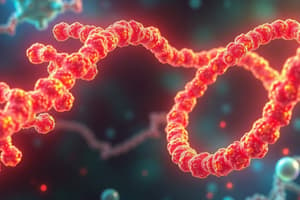Podcast
Questions and Answers
What is the function of the enzyme helicase during DNA synthesis?
What is the function of the enzyme helicase during DNA synthesis?
- Joins together the Okazaki fragments of the lagging strand
- Synthesizes a short strand of RNA called primer
- Unzips the double strand structure of the DNA (correct)
- Matches and adds new nucleotides to form daughter DNA strand
Which of the following is NOT an inhibitory effect of quinolones?
Which of the following is NOT an inhibitory effect of quinolones?
- DNA strand breakage by a direct chemical action
- Unzipping of DNA (correct)
- Blocking of DNA replication fork
- Inhibition of DNA synthesis
What is the function of the enzyme primase during DNA synthesis?
What is the function of the enzyme primase during DNA synthesis?
- Joins together the Okazaki fragments of the lagging strand
- Matches and adds new nucleotides to form daughter DNA strand
- Unzips the double strand structure of the DNA
- Synthesizes a short strand of RNA called primer (correct)
What is the spectrum of activity of metronidazole?
What is the spectrum of activity of metronidazole?
What is the mechanism of action of nitroimidazoles and nitrofurans?
What is the mechanism of action of nitroimidazoles and nitrofurans?
Which enzyme is responsible for joining together the Okazaki fragments of the lagging strand?
Which enzyme is responsible for joining together the Okazaki fragments of the lagging strand?
What is the function of the enzyme topoisomerase during DNA synthesis?
What is the function of the enzyme topoisomerase during DNA synthesis?
What is the mechanism of action of trimethoprim when used alone?
What is the mechanism of action of trimethoprim when used alone?
What is the function of the enzyme exonuclease during DNA synthesis?
What is the function of the enzyme exonuclease during DNA synthesis?
What is the main difference between fungal and bacterial cell walls?
What is the main difference between fungal and bacterial cell walls?
Which of the following is an example of an anaerobic Gram-negative bacillus that is sensitive to metronidazole?
Which of the following is an example of an anaerobic Gram-negative bacillus that is sensitive to metronidazole?
What is the name of the fungal enzyme inhibited by allylamine?
What is the name of the fungal enzyme inhibited by allylamine?
What is the mechanism by which metronidazole is activated within cells?
What is the mechanism by which metronidazole is activated within cells?
What is the brand name of terbinafine?
What is the brand name of terbinafine?
What is the mode of reproduction of yeast?
What is the mode of reproduction of yeast?
What is the type of fungus that grows partly as yeast and partly as filaments called hyphae?
What is the type of fungus that grows partly as yeast and partly as filaments called hyphae?
What is the effect of combining trimethoprim with sulfamethoxazole?
What is the effect of combining trimethoprim with sulfamethoxazole?
What is the mechanism of action of nystatin?
What is the mechanism of action of nystatin?
What is the type of fungal infection caused by Histoplasma capsulatum?
What is the type of fungal infection caused by Histoplasma capsulatum?
What is the type of fungus that reproduces by forming spores?
What is the type of fungus that reproduces by forming spores?
What is the primary target of rifampicin in bacterial cells?
What is the primary target of rifampicin in bacterial cells?
Which of the followingprotozoa is not susceptible to rifamycins?
Which of the followingprotozoa is not susceptible to rifamycins?
What is the role of tetrahydrofolate in cells?
What is the role of tetrahydrofolate in cells?
Why do sulphonamides and sulphones inhibit bacterial growth?
Why do sulphonamides and sulphones inhibit bacterial growth?
What is the difference between bacterial and mammalian cells in terms of folate utilization?
What is the difference between bacterial and mammalian cells in terms of folate utilization?
What is the mechanism of action of trimethoprim?
What is the mechanism of action of trimethoprim?
Which of the following antimicrobial agents is not an inhibitor of metabolic pathways?
Which of the following antimicrobial agents is not an inhibitor of metabolic pathways?
What is the primary use of rifampicin in clinical practice?
What is the primary use of rifampicin in clinical practice?
Which of the following is not an anaerobic Gram-positive bacillus?
Which of the following is not an anaerobic Gram-positive bacillus?
What is the difference between sulphonamides and sulphones in terms of their mechanism of action?
What is the difference between sulphonamides and sulphones in terms of their mechanism of action?
What is a rare side effect associated with oral treatment of terbinafine?
What is a rare side effect associated with oral treatment of terbinafine?
What is the mechanism of action of echinocandins?
What is the mechanism of action of echinocandins?
What is the nickname of echinocandins?
What is the nickname of echinocandins?
What is the organism from which caspofungin is derived?
What is the organism from which caspofungin is derived?
What is the primary action of undecylenic acid?
What is the primary action of undecylenic acid?
What is the combination of agents in Whitfield's ointment?
What is the combination of agents in Whitfield's ointment?
What is the indication for the use of Whitfield's ointment?
What is the indication for the use of Whitfield's ointment?
Which of the following fungi is not susceptible to tolnaftate?
Which of the following fungi is not susceptible to tolnaftate?
What is the mechanism of action of echinocandins similar to?
What is the mechanism of action of echinocandins similar to?
What is the antifungal compound that is primarily fungistatic but may exhibit fungicidal activity at high concentrations?
What is the antifungal compound that is primarily fungistatic but may exhibit fungicidal activity at high concentrations?
Flashcards are hidden until you start studying
Study Notes
Nucleic Acid Synthesis Inhibitors
- Nucleic acids, including DNA and RNA, are biopolymers made up of monomers called nucleotides.
- Enzymes involved in nucleic acid synthesis are attractive therapeutic targets for various diseases.
Elongation
- Primase binds to the first priming sequence on the leading strand template and synthesizes a short RNA primer that is complementary to the DNA template.
- DNA polymerase uses the primer to initiate DNA synthesis by adding deoxyribonucleotides to the 3’ end.
Enzymes Involved in Nucleic Acid Synthesis
- Helicase: unzips the double-strand structure of DNA.
- DNA polymerase: matches and adds new nucleotides to form daughter DNA strands.
- Primase: synthesizes a short strand of RNA called a primer.
- DNA ligase: joins together the Okazaki fragments of the lagging strand.
- Topoisomerase: relieves the stress generated by unzipping of DNA.
- Exonuclease: removes short segments of primers and is replaced by DNA polymerase.
Quinolones
- Nitroimidazoles and Nitrofurans (e.g., Metronidazole and Nitrofurantoin): cause DNA strand breakage by direct chemical action.
- The nitro group of Metronidazole is converted to nitronate radical by low redox potentials within the cells.
- The activated Metronidazole then attacks the DNA, producing strand breakage.
Spectrum of Activity of Metronidazole
- Active only against anaerobic organisms.
- Anaerobic Gram-negative bacilli: Bacteroides fragilis, Bacteroides species, Fusobacterium spp., Porphyromonas spp., Prevotella spp.
- Anaerobic Gram-positive bacilli: Clostridium spp.
- Anaerobic gram-positive cocci: Peptostreptococcus species, Veillonella species.
- Also an antiprotozoan: effective against Blastocystis hominis, Entamoeba histolytica, Giardia lamblia, Trichomonas vaginalis.
Rifamycins
- Rifampicin is a semisynthetic member of the rifamycin family and functions by blocking RNA polymerase activity in bacteria.
- The RNA polymerase enzymes in bacteria are structurally different from those in eukaryotes, providing for selective toxicity against bacterial cells.
- Used for the treatment of various infections, including tuberculosis.
Inhibitors of Metabolic Pathways
Folate Metabolism
- Folic acid is an essential co-factor in all living cells.
- In its reduced form (Tetrahydrofolate THF), folic acid functions as a carrier of single carbon fragments used in the synthesis of adenine, guanine, thymine, and methionine.
- Bacteria, protozoa, and mammalian cells possess Dihydrofolate receptor (DHFR), but there are sufficient differences in the enzyme structure for inhibitors like trimethoprim to inhibit bacterial enzymes selectively.
Sulphonamides and Sulfones
- Structural analogues of PABA.
- Competitively inhibit the incorporation of PABA into dihydropteroic acid, inhibiting subsequent metabolism.
- Bacteriostatic inhibition of growth against a broad spectrum of gram-positive and gram-negative pathogens.
Trimethoprim
- Synthetic antimicrobial compound that serves as an antimetabolite in the same folic acid synthesis pathway as sulphonamides.
- Selective inhibitor of bacterial dihydrofolate reductase.
- Used in combination with sulfa drugs, such as sulfamethoxazole, to treat urinary tract infections, ear infections, and bronchitis.
Antifungal Agents
- Fungi are eukaryotic organisms that live as saprobes or parasites.
- Fungal cell membrane contains ergosterol, whereas human cell membrane contains cholesterol.
- Antibacterial agents are not effective against fungi.
- Fungal infections are also called mycoses.
Types of Fungi
- Yeasts: reproduce by budding (e.g., Cryptococcus neoformans, which causes cryptococcal meningitis).
- Yeast-like fungi: grow partly as yeast and partly as filaments called hyphae (e.g., Candida albicans, which causes oral, vaginal, and systemic candidiasis).
- Dimorphic fungi: grow as mould or as yeast (e.g., Histoplasma capsulatum, which causes histoplasmosis).
- Moulds: filamentous fungi that reproduce by forming spores (e.g., Dermatophytes, which cause hair, skin, and nail infections such as ringworm).
Nystatin
- Isolated from Streptomyces noursei.
- Polyene macrolide similar to amphotericin B in structure and action.
- Used for superficial candidiasis of the mouth, skin, vagina, and intestine.
- More toxic than Amphotericin B when used parenterally.
Allylamine
- E.g., Terbinafine, Butenafine, Naftifine.
- Inhibit the fungal enzyme Squalene epoxidase, which converts squalene to lanosterol.
- Leads to a reduction in lanosterol production, affecting cell membrane function and integrity.
- Fungicidal.
- Terbinafine is used topically for the treatment of dermatophytic skin infections like athlete’s foot, ringworm, and jock itch.
Echinocandins
- The echinocandins, including caspofungin, are naturally produced antifungal compounds.
- Caspofungin is derived from the fermentation product of Glarea lozoyensis.
- Blocks the synthesis of β(1→3) glucan found in fungal cell walls but not in human cells.
- Used for the treatment of aspergillosis as well as systemic yeast infections.
Other Topical Agents
- Tolnaftate: effective against most cutaneous mycoses caused by Trichophyton rubrum, T. tonsurans, M. gypseum, and M. canis, but ineffective against Candida.
- Undecylenic acid: used in the treatment of various dermatomycoses, especially tinea pedis; primarily fungistatic but may exhibit fungicidal activity with long exposure to high concentrations.
- Benzoic acid and salicylic acid: components of Whitfield's ointment, which combines the fungistatic action of benzoate with the keratolytic action of salicylate; used for the treatment of tinea pedis.
Studying That Suits You
Use AI to generate personalized quizzes and flashcards to suit your learning preferences.





